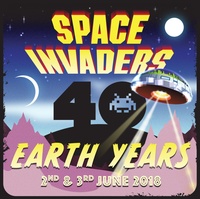|
40 Years of Space InvadersAfter the first mass market video game “Pong” was released in 1972, the world was never the same again. Initially dismissed as a fad, video games went on to be a cultural touchstone and new form of entertainment; they were easily accessible like movies and television but were distinguished by their key feature: interactivity. Pong paved the way for more early video games in the 1970s, including the iconic Space Invaders. For many people, Space Invaders was both a new genre of video game and worldwide phenomenon when it was released in 1978.
Tomohiro Nishikado created Space Invaders when the science fiction movie zeitgeist reached its zenith: the release of Star Wars. His creation was credited by many as transforming video games from niche product to mass consumer appeal. While simple in execution, Space Invaders was fun and addictive. Shortly after it’s release, long queues of eager people formed in arcade venues across the world waiting to play it.
From the beginning, technical limitations of the day influenced the game’s design. In the pioneering days of video games, hardware and software tools had to be created from scratch. Looking back on Space Invaders some years later, Nishikado said: “The hardest part was the development of a microcomputer…These days, we have personal computers to rely on, but..back then.. I had to create everything by myself. I created a development device, wrote a part of the game that runs on it, and then created more devices along the way.” Originally Nishikado had conceived the player shooting people, planes and tanks but the graphics didn’t look good on the hardware. In any case, Taito executives were not comfortable with the idea of shooting people. He told USA Today in 2008: “when Taito saw the prototype, they said, ‘You can’t shoot people! And you must not create the image of war.’ So I changed the characters into monsters.” To design the aliens (or monsters), Nishikado took inspiration from marine life like squids, crabs and octopuses.
Space Invaders in Pop CultureInitially released in Japan during the summer of 1978, Space Invaders enjoyed popularity hitherto unseen, with demand so high that new arcade venues opened with nothing but Space Invaders cabinets. There were even rumours that the nation’s obsession with Space Invaders had led to a 100-yen coin shortage. This was an improbable (and since debunked) notion, but made for good marketing nonetheless. Many compare the cultural phenomenon of Space Invaders to that of “The Beatles” pop group in the 1960s: overwhelming, immediate and all encompassing. Popularity of the game soon spread globally. News media picked up on this, often calling it a “craze” and besides noting the game’s financial success, would often attribute Space Invaders with corrupting the current generation of youth. Even the medical community became involved, identifying health issues such as “Space Invaders wrist” and “elbow”. Here in Britain, the craze managed to attract the attention of Parliament. A Private Member’s Bill, “the Control of Space Invaders (and other Electronic Games)” was put forward by Labour MP George Foulkes. He wanted to give local councils the power to regulate Space Invaders and other similar games through a licensing scheme because it caused “deviancy”. As deviant as Space Invaders was, other MPs scoffed at the idea of regulating an electronic game in the same way a council would regulate gambling or alcohol. Thankfully, Parliament dismissed the Bill and it never came to pass.
Influence on Gaming CultureCountless shoot’em up games over the last 40 years can trace their lineage to Space Invaders. Most notably early after the game’s release, Galaxians and Galaga advanced the genre with more complex and graphically impressive waves of aliens. In the late ‘80s, R-Type and Xenon 2:Megablast had a big impact on home computers and consoles. Many game developers have cited Space Invaders as an influence, with John Romero and John Carmack, the creators of Doom and Wolfenstein 3D stating it was their introduction to video games.
It is difficult to overestimate the impact Space Invaders had on the video game industry. Introduced after the first “video game crash” brought about by huge numbers of low quality Pong clones, Space Invaders breathed new life into the arcade scene, helped resurrect home game consoles and went down in history as the first ever video game “blockbuster”. On the 2nd & 3rd of June, the Centre for Computing History will be celebrating 40 years of Space Invaders with a weekend retrospective featuring 40 versions of the game, an Atari 2600 Space Invaders competition and a ticketed evening event featuring a panel discussion on all aspects of the game, from the technical to the cultural. For more information and to book your tickets click the link below ... Space Invaders - 40 Earth Years
Date : Unknown This exhibit has a reference ID of CH47162. Please quote this reference ID in any communication with the Centre for Computing History. |
Click on the Images For Detail
|

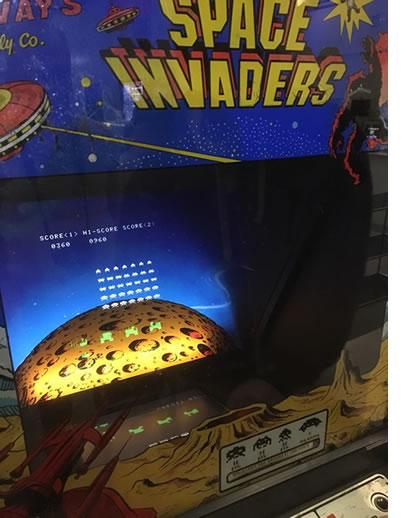 Space Invaders is widely considered to be the first commercial “shoot’em up” game altough some people contest this due to a lack of consensus on the definition of “shoot’em up”. It used simple and intuitive play mechanics. The player pilots a spaceship and is tasked with shooting down hordes of aliens. The aliens move left to right in shifting rows that gradually descend towards the bottom of the screen. The player’s ship floats behind three strategically placed barriers, partially protecting the player from attack. The more aliens are shot down, the quicker the remaining aliens move. The ever increasing speed and corresponding sound effects put the player under more and more pressure to shoot quickly and accurately. After a complete wave of aliens is shot down a new wave appears, moving slightly quicker and firing more bullets than before. It’s easily understood objective coupled with great graphics and sound (for the time) are key reasons for the game’s success.
Space Invaders is widely considered to be the first commercial “shoot’em up” game altough some people contest this due to a lack of consensus on the definition of “shoot’em up”. It used simple and intuitive play mechanics. The player pilots a spaceship and is tasked with shooting down hordes of aliens. The aliens move left to right in shifting rows that gradually descend towards the bottom of the screen. The player’s ship floats behind three strategically placed barriers, partially protecting the player from attack. The more aliens are shot down, the quicker the remaining aliens move. The ever increasing speed and corresponding sound effects put the player under more and more pressure to shoot quickly and accurately. After a complete wave of aliens is shot down a new wave appears, moving slightly quicker and firing more bullets than before. It’s easily understood objective coupled with great graphics and sound (for the time) are key reasons for the game’s success. 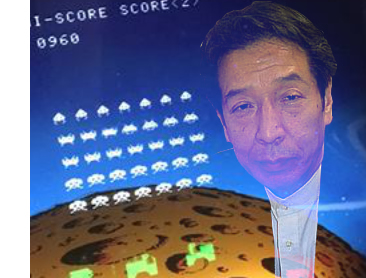 Nishikado was hired initially to help the Japanese Taito corporation with its ubiquitous line of pachinko and vending machines. In 1972 he designed Taito’s first electronic game (a Pong clone), impressing company executives. Nishikado would go on to develop other games before starting work on Space Invaders in 1977. His game was partly inspired by play mechanics from popular brick breaking video games such as Break-Out, but rather than have the player remove bricks by deflecting a ball, Nishikado envisioned shooting a projectile at incoming waves of bricks (aliens would replace bricks later in development).
Nishikado was hired initially to help the Japanese Taito corporation with its ubiquitous line of pachinko and vending machines. In 1972 he designed Taito’s first electronic game (a Pong clone), impressing company executives. Nishikado would go on to develop other games before starting work on Space Invaders in 1977. His game was partly inspired by play mechanics from popular brick breaking video games such as Break-Out, but rather than have the player remove bricks by deflecting a ball, Nishikado envisioned shooting a projectile at incoming waves of bricks (aliens would replace bricks later in development).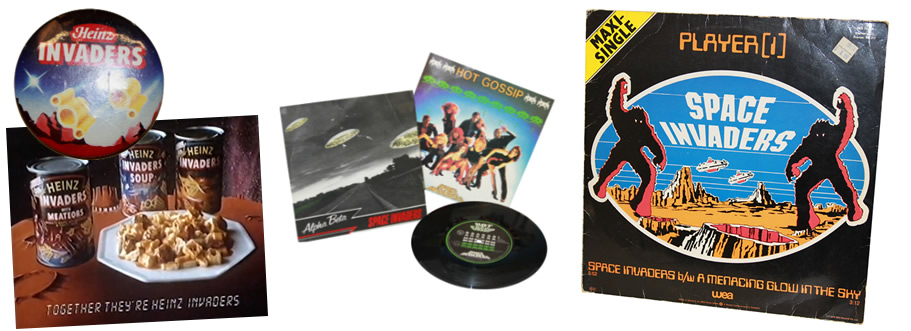
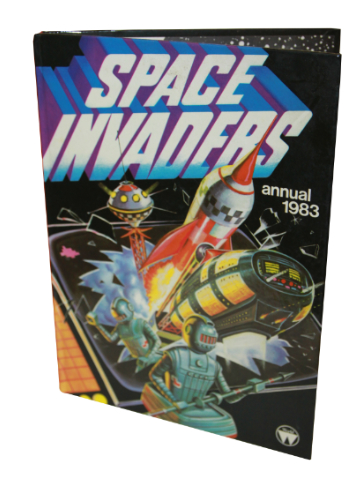 Even food companies wanted their products to be associated with the game. Most famously in Britain, Heinz produced pasta-and-sauce Space Invaders and tomato ketchup. Of course, alongside the food and music, Space Invaders also spawned a selection of t-shirts, posters, toys, novelties and books and even a Space Invaders annual for good measure.
Even food companies wanted their products to be associated with the game. Most famously in Britain, Heinz produced pasta-and-sauce Space Invaders and tomato ketchup. Of course, alongside the food and music, Space Invaders also spawned a selection of t-shirts, posters, toys, novelties and books and even a Space Invaders annual for good measure.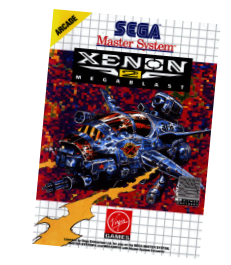 Today, 2D shoot’em ups are still popular, with new games released frequently, whilst 3D first person shooters are mainstream successes with game play ideas influenced by Space Invaders.
Today, 2D shoot’em ups are still popular, with new games released frequently, whilst 3D first person shooters are mainstream successes with game play ideas influenced by Space Invaders. 